What it’s like to have purple pee because of acute porphyria
What could've been a solid clue went undiagnosed for years
Written by |

My urine turns a reddish shade of purple when I’m sick. It resembles pomegranate juice, lightly staining the toilet bowl with a ring of fuchsia. This is a symptom unique to acute intermittent porphyria (AIP). The word “porphyria” is even derived from the ancient Greek word for purple.
During an attack of abdominal pain when I was a teenager, I stared down into the toilet bowl and wondered if the color had something to do with my period. I didn’t ask anyone, and this cycle of extreme pain resulting in fire-engine-colored urine became an occasional occurrence. I flushed and moved on.
Misdiagnosis
I was 21 when I finally showed someone my urine.
After days of severe abdominal pain, I descended the brick staircase into the depths of my college’s commons building, where the student health clinic was located. Agony hunched my shoulders to protect my belly. My legs moved in a stiff, shaky shuffle.
“Let’s take a pregnancy test,” a nurse suggested, thrusting me a clear plastic cup. The providers were notorious among students for urine testing prior to any consultation, despite any symptoms.
Minutes later, when I placed my sample in front of her, she tilted her head quizzically. It was likely the first time she’d seen urine that particular hue. “It’s blood,” she announced, after clearing her throat.
Growing in confidence, she explained that my pain was likely due to a kidney stone I was passing. “It must be rolling around in your bladder and causing light bleeding.”
The night before, horrendous pain had jolted me awake. Collapsing in the bathroom, I’d been unable to do anything but lie on my side, hug my knees, and softly sob. What I didn’t admit to the nurse was that I knew my symptoms were severe because I’d stayed the night at my boyfriend’s house. I spent hours in the damp, hair-covered, stained, sticky bathroom he shared with three other 21-year-old dudes. Who knows if the floor mat I lay on had ever been washed.
“It’ll pass eventually,” she assured me. “But you will be in some pain until then.”
I felt relieved. Another person had looked at my urine and given me an answer. Never mind that the explanation did nothing to address my pattern of pain from previous years. She referred me to a specialist for testing.
By the time I made it to see the urologist, my urine color was back to normal and my pain had mostly subsided. There was no kidney stone — there never was — but he wasn’t concerned about my reports of pain anyhow. He assured me everything looked good.
I flushed and moved on.
Confusion
Shortly before my diagnosis, I was hospitalized for several weeks. My mom dropped everything and sat in my hospital room. Unable to eat or drink, I took in intravenous fluids. A white, plastic measuring cup tucked under the toilet seat caught my urine for a nurse technician to collect and record. Soon, my body started performing its trick. I was surprised to see the color of my urine become extra dramatic after it sat out in the bathroom.
A group of providers theorized why my gastrointestinal tract remained paralyzed. After exhaustive testing, the general consensus was that I was constipated from IV medicine. My heart fell into its lockbox of shame, plus I was too weak to argue.
I heard my mom scoff, sounding irritated. I watched her stride into the bathroom. “Can you explain why her urine looks like this?” she asked, gesturing desperately toward the toilet.
Sadly, even berry-colored urine wasn’t enough of a giveaway. It never crossed my mind that I could have a disease so rare that most doctors have never seen it.
Management
I was raised to rely on medical providers to know everything going on with my body. Since my diagnosis, I’ve come to realize this is an unfairly high expectation to put on people who are overworked as it is. Especially when the odds of treating someone whose AIP presents just like mine is unlikely.
As an adult living with a rare disease, I’m the expert of my own body, and my lived experience navigating the world has tremendous, but often unrecognized, value. I’ve learned more about the phenomenon of porphyria pee from peers in the porphyria community than from any published study or medical consultation.
It’s been over six years since I started managing my AIP, and I’ve completely changed the way I think about this symptom. Before I knew anything about my disease, the color in the toilet bowl came with confusion. Now, it serves as a warning that the levels of porphyrins in my body are increasing. Thankfully, by taking proper medication and living cautiously, my urine rarely gets as purple as it used to.
Note: Porphyria News is strictly a news and information website about the disease. It does not provide medical advice, diagnosis, or treatment. This content is not intended to be a substitute for professional medical advice, diagnosis, or treatment. Always seek the advice of your physician or other qualified health provider with any questions you may have regarding a medical condition. Never disregard professional medical advice or delay in seeking it because of something you have read on this website. The opinions expressed in this column are not those of Porphyria News or its parent company, Bionews, and are intended to spark discussion about issues pertaining to porphyria.







Leave a comment
Fill in the required fields to post. Your email address will not be published.